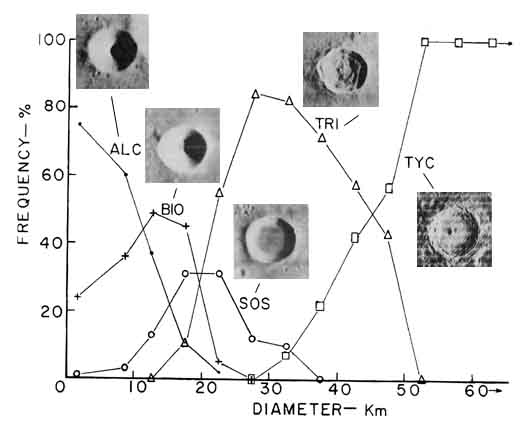Difference between revisions of "Crater Classification"
| Line 3: | Line 3: | ||
(glossary entry)<br /> <div id="toc"> | (glossary entry)<br /> <div id="toc"> | ||
=Table of Contents= | =Table of Contents= | ||
| − | <div style="margin-left: 1em">[#toc0 ]</div><div style="margin-left: 2em">[#x-Description Description]</div><div style="margin-left: 2em">[#x-Additional Information Additional Information]</div><div style="margin-left: 2em">[#x-LPOD Articles LPOD Articles]</div><div style="margin-left: 2em">[#x-Bibliography Bibliography]</div></div>In the unpublished catalog<br /> <br /> Wood, C.A. and Andersson, L.E. (1978) ''[ | + | <div style="margin-left: 1em">[#toc0 ]</div><div style="margin-left: 2em">[#x-Description Description]</div><div style="margin-left: 2em">[#x-Additional Information Additional Information]</div><div style="margin-left: 2em">[#x-LPOD Articles LPOD Articles]</div><div style="margin-left: 2em">[#x-Bibliography Bibliography]</div></div>In the unpublished catalog<br /> <br /> Wood, C.A. and Andersson, L.E. (1978) ''[[Lunar%20%26%20Planetary%20Laboratory%20Catalog%20of%20Lunar%20Craters|Lunar & Planetary Laboratory Catalog of Lunar Craters]]: Part 1: Nearside.'' NASA TM 79328 (in press)<br /> <br /> every crater was classified according to its morphology. This had rarely been attempted before and the LPL Catalog offered valuable new information. Fresh craters were classified into 5 different morphologies:<br /> <br /> |
* ALC- bowl-shaped craters with smooth rims, diameters up to 20 km; prototype Albategnius C | * ALC- bowl-shaped craters with smooth rims, diameters up to 20 km; prototype Albategnius C | ||
* BIO - flat-floored craters with similar morphology and diameter range as ALC but with a flat floor having a clear break in slope at the contact with the crater wall; prototype Biot | * BIO - flat-floored craters with similar morphology and diameter range as ALC but with a flat floor having a clear break in slope at the contact with the crater wall; prototype Biot | ||
Revision as of 14:44, 15 April 2018
Contents
18
(glossary entry)Table of Contents
[#toc0 ]
[#x-Description Description]
[#x-Additional Information Additional Information]
[#x-LPOD Articles LPOD Articles]
[#x-Bibliography Bibliography]
Wood, C.A. and Andersson, L.E. (1978) Lunar & Planetary Laboratory Catalog of Lunar Craters: Part 1: Nearside. NASA TM 79328 (in press)
every crater was classified according to its morphology. This had rarely been attempted before and the LPL Catalog offered valuable new information. Fresh craters were classified into 5 different morphologies:
- ALC- bowl-shaped craters with smooth rims, diameters up to 20 km; prototype Albategnius C
- BIO - flat-floored craters with similar morphology and diameter range as ALC but with a flat floor having a clear break in slope at the contact with the crater wall; prototype Biot
- SOS - relatively shallow craters with broad flat floors and terrace-free narrow walls, diameters 5-35 km; prototype Sosigenes
- TRI - scalloped-walled craters typically 15-50 km in diameter, with sub-angular or scalloped outline; broad often roughly concentric slump masses in wall with flat floor partially or completely obscured by slumped material; prototype Triesnecker
- TYC - craters with multiple tiers of teraces, crenulated rim crest, large flat floor, diameters 30 - 175 km; prototype Tycho.

image from LPOD Sept 23, 2004.
Degraded craters had additional classifications including ABU, CAP, GAM, and UNC - these will be described later.
Because the LPL Catalog was never published the classification information remains unavailable 30 years later. Classifications are on a partial copy of the LPL Catalog and they will be added, slowly, to the Moon Wiki. None of the farside craters had been classified so skilled visitors to the Moon Wiki can examine images of those craters and add classifications to the Additional Information sections of page; when approved each will be transfered to the data block at top.
- tychocrater tychocrater Feb 24, 2008
Description
Additional Information
LPOD Articles
A New/Old Catalog of Lunar Craters
Lunar Crater Types
Bibliography
- Stoper, J. D. et al (2017) Relative depths of simple craters and the nature of the lunar regolith – Icarus - Vol 298, pp 34-38, December 2017.
- van der Bogert, C. H. et al (2017) Origin of discrepancies between crater size-frequency distributions of coeval lunar geologic units via target property contrasts – Icarus - Vol 298, pp 49-66, December 2017.
- Wood, C.A. and L. Andersson (1978) New morphometric data for fresh lunar craters. Lunar and Planetary Science Conference, 9th, Proceedings. New York, Pergamon Press, Inc., p. 3669-3689.
This page has been edited 1 times. The last modification was made by - tychocrater tychocrater on Jun 13, 2009 3:24 pm - mgx2